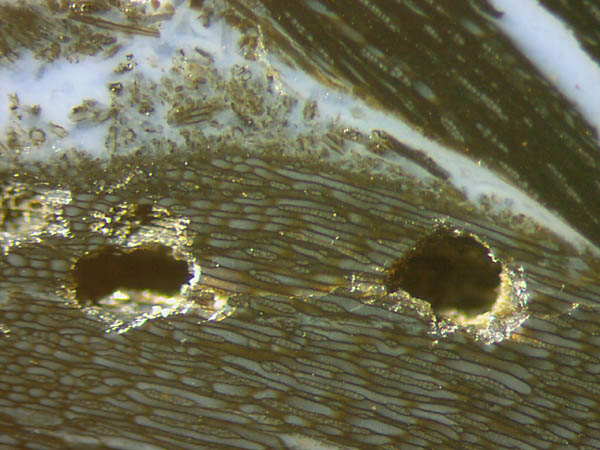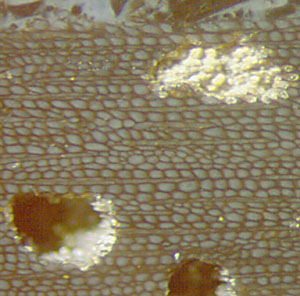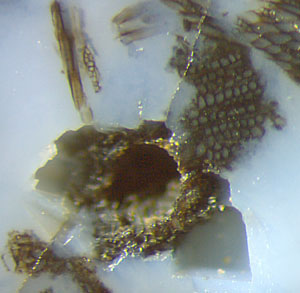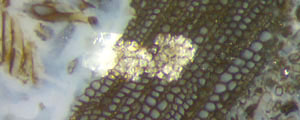Permian wood implications:
no
charcoal, no
creatures
This headline applies to one particular chert sample from the Lower
Permian Döhlen basin which had given rise to doubts about details of
established palaeobotany, for the following reason:
Fragments of black wood in white
chalzedony had been interpreted as silicified charcoal at
first sight (Fig.1).
Palaeobotanists had claimed that not wood but only charcoal would
show brittle fracture with fragments as small as those
seen here. Erroneous but seemingly reasonable argumentation can cause persistent irritation, hence it must be contradicted.
This
has been done with detailed discussion in [1].

Fig.1: Permian wood, silicified
together with the water where it had lain and
become degraded, torn and
broken into fragments while soft, with enigmatic holes. Picture width 11mm.
The mistrust raised by the alleged charcoal had spread to the
alleged frass
galleries and coprolites ascribed to unseen oribatid mites, unknown
creatures, or
insects. There is a
considerable amount of scientific work on the subject, part of which
has been discussed and declared erroneous repeatedly
until the mites craze apparently waned [3,4].
Lately, "beetle borings in wood" [2],
have newly aroused the curiosity about any
holes and coprolites in silicified wood. The
alleged coprolites of the (unseen) beetles in [2] look like degraded wood
fragments of various sizes and shapes similar as in [1].
The ongoing dispute about damage in petrified
wood suggests a closer inspection
of this sample, [1].
Conspicuous
in Fig.1 are the rough holes in the wood, apparently arranged
in a row, incidentally or not. They resemble the
orderly row of "beetle
borings" in [2].
Fig.2 (below): Holes of uncertain origin in Permian wood with big and tiny fragments, detail of Fig.1. Picture
width 2.8mm. Same
scale in Figs.2-5.

What is seen here is incompatible with an interpretation as silicified
charcoal. Contradicting
the above-mentioned argument it can be stated that breaking
charcoal would never release
cells as a whole as seen in Figs.2,4. A
charcoal interpretation is also precluded by the round contour
of the big fragment in Fig.1. After
lying in the water for some time, the wood had lost its
strength so that it deformed easily when torn,
and individual cells split off.

 While
the charcoal idea is easily refuted here, an interpretation of the
irregular-shaped holes seems more problematic. Luckily, a few of them
provide indications concerning their nature.
While
the charcoal idea is easily refuted here, an interpretation of the
irregular-shaped holes seems more problematic. Luckily, a few of them
provide indications concerning their nature.
Fig.3 (2nd left):
Permian wood with white
spot in the tissue, there cells not
fused by silicification.

Fig.4 (above right):
Permian wood fragments with irregular hole and regular
voids in chalcedony from dissolved calcite crystals.
Fig.5: Calcite crystal grown inside and outside
Permian wood
without pushing the tissue aside.
The white spot in Fig.3 offers
a first clue: The cells with white fill are not fused but rather loose.
(They could be mistaken for coprolites by those who would like to
find any.) What remains to be done is to offer
an explanation of the strange phenomenon of loose cell-size clots
amidst solid petrified wood.
A second clue is provided by Fig.4 where one of the enigmatic holes is
seen in a small wood fragment surrounded by voids shaped like calcite
crystals. Voids left by dissolved crystals are also seen in Fig.1.
These
observations suggest the assumption that the irregular holes, too, may
somehow be
related to calcite. This seems to be supported by a
third clue, the
lucky incidence of one small calcite crystal cut such that it is seen
inside
and outside the wood
on one of the cut faces
of the sample: Fig.5.
The observations suggest a tentative explanation based on various steps:
(1) Calcite crystals may grow while Permian chert is forming from
silica
gel.
(2) Calcite may grow right through the tissue
without pushing it aside, as in Fig.5.
It can be assumed that the calcite suppresses silicification there.
(3) The affected wood cells become filled with calcite but
their walls remain poorly or not mineralized so that the fills may
appear as separate cell-size clots, as in Fig.3.
(4) The calcite may dissolve and vanish, as seen
in Fig.4 where
the crystals have left angular voids in the chalcedony.
(5) Calcite in the wood as in
Figs.3,5 may leave a fragile network of cell walls when
dissolving, which may collapse and leave big holes as in Figs.1-4.
This tentative
explanation of the conspicuous holes in Figs.1-4 may be suitable for
critical reconsiderations of wood damage ascribed to creatures.
Suspicion concerning the beetle borings in [2] seems
justified by the fact that the alleged
frass galleries and coprolites ascribed to never seen oribatid mites
in several publications by Feng
and Rößler
have turned out erroneous [3]. The alleged coprolites
are mostly cell fills consisting of fungus matter.
By the way, the
present contribution indicates another possibility for the formation of
cell-size clots which could be mistaken for mite coprolites: It is the
deposition of crystalline calcite along with silicification, which may
produce an
assemblage of more or less loose cells filled with the mineral, as in
Fig.3.
As mentioned above, a hole remains when the calcite dissolves.
The observed roughly cylindrical shape of the big holes would imply a
corresponding arrangement of the deposited and later dissolved calcite.
How a cylindrical configuration
could be brought about remains an uncertain item in the logic
of interpretation.
Despite
of some uncertainty, an alternative interpretation of the beetle
borings in [2] as a purely mineral phenomenon similar as with
the holes in this sample of Permian wood should be considered.
Sample found in 1992 at
Wilmsdorf golf course, Possendorf near Dresden; kept in the own collection, label W/55, Parts 3,4.
H.-J.
Weiss 2020
[1] Fossil
Wood News 9 :
Permian wood misinterpreted as fossil charcoal.
[2] Z. Feng,
..., R. Rößler:
Beetle borings in wood with host response in early Permian conifers
from Germany, Paläontol. Z. (July 2019)
[3] Fossil
Wood News 16 : Elusive
creatures in fossil wood – Clean-up in the wake of a
waning obsession.
[4] Fossil
Wood News 29 : Alleged
fossil wood burrows.
|

|
 38 38 |

 38
38


 While
the charcoal idea is easily refuted here, an interpretation of the
irregular-shaped holes seems more problematic. Luckily, a few of them
provide indications concerning their nature.
While
the charcoal idea is easily refuted here, an interpretation of the
irregular-shaped holes seems more problematic. Luckily, a few of them
provide indications concerning their nature. 

 38
38